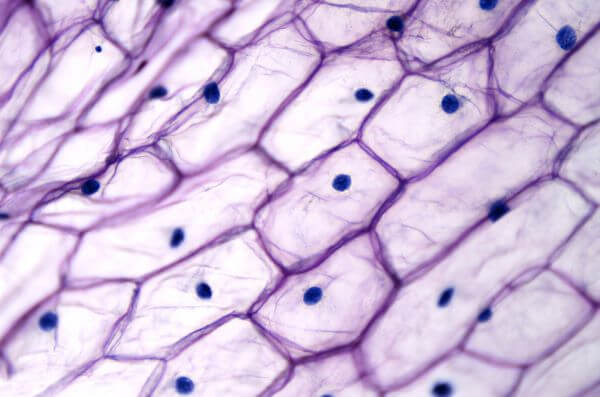Cells are the fundamental units of life on Earth, and they are the building blocks that make up all other living things. Every cell contains a set of organelles; subcellular structures that are specially adapted to carry out the necessary functions of life.
Some organelles (including the nucleus, mitochondria, and endoplasmic reticulum) are found in virtually all eukaryotic cells. Others (like chloroplasts) are only found in certain cell types, such as plant cells and algae.
Animal Cell Organelles
Animal cells contain numerous organelles (literally meaning ‘little organs’) to help them carry out the functions essential to their survival.
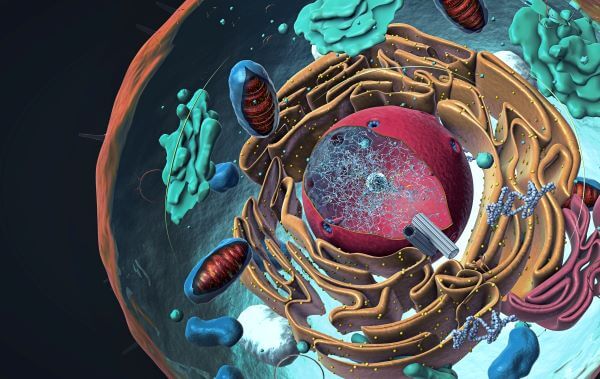
The Nucleus
The nucleus is a key structure in all eukaryotic cells, as it stores all of the cell’s DNA (and therefore, genetic information). The nucleus also controls and regulates all the vital functions of the cell, including protein production, cell division, metabolism, and growth.
DNA molecules also contain the blueprints for every protein in an organism and must be carefully preserved to maintain successful protein production. The nucleus is, therefore, surrounded by a double membrane called the nuclear envelope, which protects the DNA by keeping it separate from the rest of the cell.
Mitochondria
Mitochondria are often referred to as the ‘powerhouses of the cell,’ as they release the energy required to power all other cellular functions. These organelles are the site of respiration, a metabolic process in which glucose is broken down to release energy. The energy released by cellular respiration is used to produce ATP (adenosine triphosphate) molecules. ATP is the energy currency of cells and is used to fuel all other essential cellular processes.
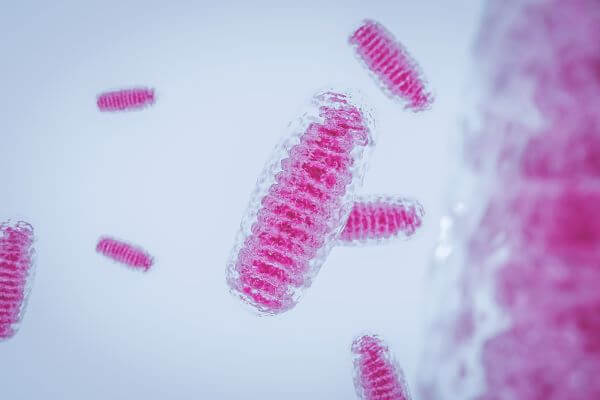
Ribosomes
Ribosomes are ‘protein factories’ and are the site of protein production in cells. These organelles ‘read’ the instructions stored in DNA molecules and use these to assemble polypeptide chains (long chains of amino acids). These are then folded into the secondary, tertiary, and quaternary structures that allow the protein to fulfill its specific function.
Rough Endoplasmic Reticulum (Rough ER)
The rough ER is so-named because its membrane is studded with ribosomes, giving it a ‘rough’ appearance. After these ribosomes have finished assembling a polypeptide chain, the protein is released into the lumen of the RER. Once inside, it is folded into a complex, 3D structure that is specific to the type of protein. The RER is also where proteins are ‘tagged’ for transport to the Golgi apparatus. ‘Tagging’ usually involves the addition of a carbohydrate molecule to the protein, in a process that is known as glycosylation.
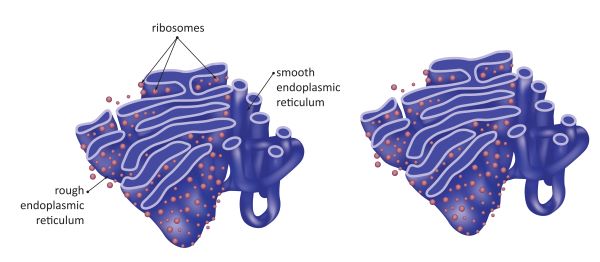
Smooth Endoplasmic Reticulum (Smooth ER)
The main difference between the rough ER and the smooth ER is that the smooth ER does not have ribosomes attached to its surface. The smooth ER is not involved in protein synthesis; instead, it is the site of lipid and steroid production in the cell.
Golgi Apparatus
Newly synthesized proteins are sent to the Golgi apparatus after they leave the rough ER. The Golgi apparatus (a series of flattened, membrane-bound sacs) is like the ‘mailroom’ of the cell and packages new proteins into tiny, membrane-bound vesicles for distribution. Once packaged, the proteins are sent off to the outer cell membrane, where they either leave the cell or become part of the lipid bilayer.
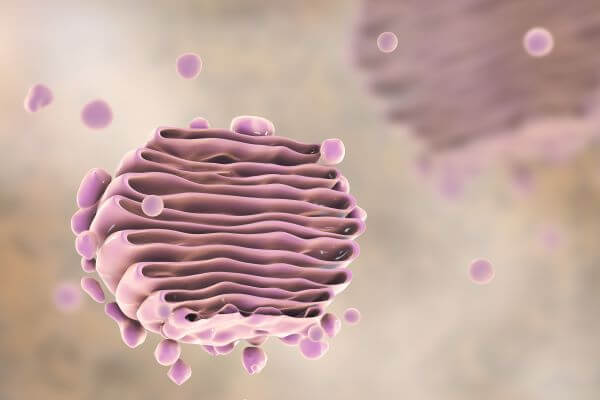
Vacuoles
Some animal cells contain vacuoles, which are typically small organelles used to transport substances in and out of the cell. They are often used to contain and dispose of waste products.
Lysosomes
Lysosomes are spherical organelles filled with digestive enzymes, and they have several functions within cells. They are used to break down old or surplus cell parts, destroy invading pathogens, and also play a key role in programmed cell death (AKA apoptosis).

Peroxisomes
Peroxisomes are similar to lysosomes in that they are spherical organelles that contain digestive enzymes. However, unlike lysosomes (which primarily break down proteins), peroxisomes degrade fatty acids. This is a major source of metabolic energy for the cell, which can be used to fuel other cellular processes.
The Cell Membrane
All cells are surrounded by a cell membrane (AKA the plasma membrane). In eukaryotic cells, cell membranes also surround each of the cell’s organelles. This compartmentalizes the contents of the cell and keeps the vital (but incompatible) metabolic processes of different organelles separate.
The main function of the cell membrane is to create a physical barrier between the interior of the cell and the external environment. However, it also controls the movement of substances in and out of the cell. The cell membrane consists of a semipermeable lipid bilayer that is studded with channels and receptors to allow certain molecules through. Therefore, the cell membrane helps to keep toxins out of the cell, while ensuring that valuable resources (such as nutrients) can enter. It also allows waste and metabolic products to leave the cell.

Cytoplasm
The cytoplasm is a jelly-like substance that fills up the spaces inside cells. It cushions and protects the organelles, and also gives cells their shape. The cytoplasm is composed of water, salts, and other molecules required for cellular processes.
Plant Cell Organelles
Plant cells contain all of the same organelles as animal cells, including mitochondria, a nucleus, ribosomes, smooth and rough ER, Golgi apparatus, lysosomes, peroxisomes, cytoplasm, and a cell membrane. However, they also contain some subcellular structures that are absent in animal cells, such as chloroplasts, a vacuole, and a cell wall.
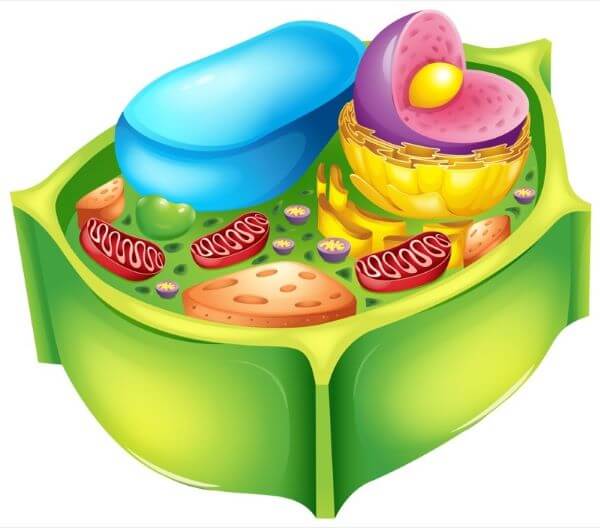
Chloroplasts
Plant cells have one key function that animal cells don’t, and that’s food production. Plant cells can produce glucose via a process called photosynthesis, which takes place in organelles called chloroplasts.
Chloroplasts are filled with a green pigment called chlorophyll, whose function is to harvest light energy from the sun. This light energy is used to fuel photosynthesis, which converts carbon dioxide and water into glucose. Once the glucose has been synthesized, it is sent to the mitochondria. Here, it is used in cellular respiration to release energy, which the plant cell then uses to fuel its other vital processes.
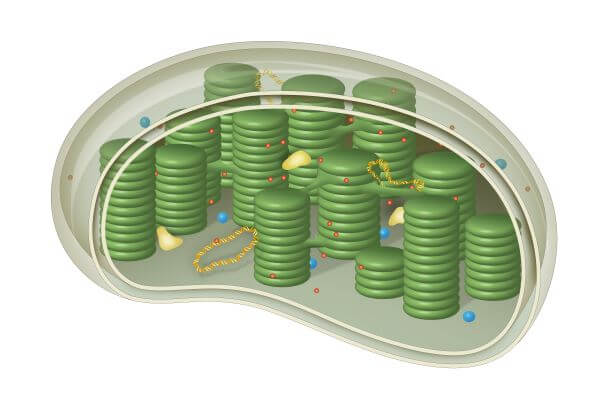
The Vacuole
The vacuole is a large, sap-filled bubble found in plant cells. Unlike animal cell vacuoles (which are usually small and distributed throughout the cytoplasm) plant cell vacuoles are very large and may take up most of the interior space of the cell.
The plant cell vacuole has several functions. It helps to maintain the shape and turgidity of the plant cell, making it very important for structural support. The vacuole also stores water, nutrients, pigments, salts, minerals, proteins, and waste products. It contains many substances that are vital for the survival of the plant cell.
In the cells of flowers, the vacuole may also store the pigments that give petals their color. These can perform the dual function of attracting bees and other pollinators, while also giving the blooms a bitter taste that discourages insects and other animals from eating them.
The Cell Wall
All cells have a cell membrane, but plant cells also have a cell wall. This is a strong, sometimes flexible, but often rigid structure that is found outside of the cell membrane. Plant cell walls are primarily made of cellulose, and their primary function is to protect the plant cell and provide structural support. The cell wall is also what gives plant cells their characteristic, rectangular or box-like shape.
